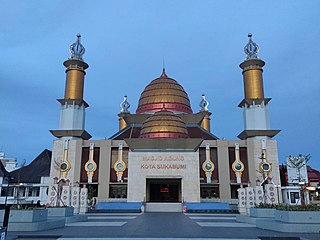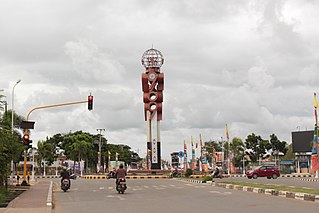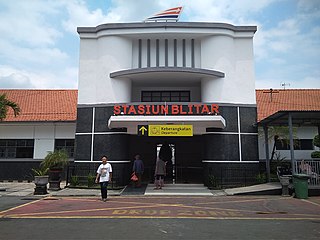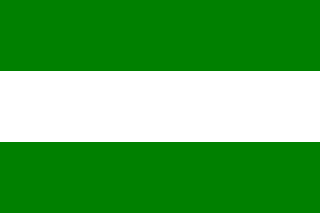
Bandung is the capital city of the West Java province of Indonesia. Located on the island of Java, Greater Bandung is the country's second-largest and second most populous metropolitan area, with over 11 million inhabitants. Situated 768 meters above sea level, approximately 140 kilometres southeast of Jakarta, Bandung has cooler year-round temperatures than most other Indonesian cities. The city lies in a river basin surrounded by volcanic mountains that provide a natural defence system, which was the primary reason for the Dutch East Indies government's plan to move the capital from Batavia to Bandung.

Sukabumi is a landlocked city surrounded by the regency of the same name in the southern foothills of Mount Gede, in West Java, Indonesia, about 100 km (62 mi) south of the national capital, Jakarta.

Merauke, also known as the District of Merauke, is a large town in South Papua, Indonesia. It is also the administrative centre of Merauke Regency. It is considered the easternmost city in Indonesia. The town was originally called Ermasoe. It is next to the Maro River where the Port of Merauke is located. As of the 2010 census, Merauke had a population of 87,634 which at the 2020 Census had increased to 102,351.
Bandung is a city in the western part of Java island in Indonesia. Beside its own city administration, Bandung also serves as the capital of the West Java province.

Ernest François Eugène Douwes Dekker also known as Setyabudi or Setiabudi was an Indonesian-Dutch nationalist and politician of Indo descent. He was related to the famous Dutch anti-colonialism writer Multatuli, whose real name was Eduard Douwes Dekker. In his youth, he fought in the Second Boer War in South Africa on the Boer side. His thoughts were highly influential in the early years of the Indonesian freedom movement.

Albert Frederik Aalbers is a Dutch architect who created elegant villas, hotels, and office buildings in Bandung, Indonesia, during Dutch colonial rule in the 1930s. Albert Aalbers worked in the Netherlands between 1924 and 1930 and then migrated to the Dutch East Indies, after which he returned to the Netherlands in 1942 due to World War II and political circumstances following Indonesian independence. During his stay in Bandung, in a period when the city was dubbed the city of architecture laboratory, a number of his buildings were considered architectural masterpieces. Aalbers' style was inspired by expressionist Frank Lloyd Wright and modernist Le Corbusier. In Bandung, the DENIS bank in Braga Street and the Savoy Homann Hotel in Asia-Afrika Street, still carry Aalber's ocean wave ornamentation.

Bosscha Observatory is the oldest modern observatory in Indonesia, and one of the oldest in Asia. The observatory is located in Lembang, West Bandung Regency, West Java, approximately 15 kilometers (9.3 mi) north of Bandung. It is situated on a hilly six hectares of land and is 1,310 m (4,300 ft) above mean sea level plateau. The IAU observatory code for Bosscha is 299.

Kiaracondong Station (KAC) or commonly known as Kircon Station is the second largest railway station in Bandung, West Java, Indonesia. It is located near the Kiaracondong street, on the Kiaracondong district, Bandung. The station located near the Kiaracondong traditional market and Kiaracondong fly over road.

The Dutch East Indies, also known as the Netherlands East Indies, was a Dutch colony with territory mostly comprising the modern state of Indonesia, which declared independence on 17 August 1945. Following the Indonesian War of Independence, Indonesia and the Netherlands made peace in 1949. In the Anglo-Dutch Treaty of 1824, the Dutch ceded the governorate of Dutch Malacca to Britain, leading to its eventual incorporation into Malacca (state) of modern Malaysia.

Parahyangan or Priangan is a cultural and mountainous region in West Java province on the Indonesian island of Java. Covering a little less than one-sixth of Java, it is the heartland of Sundanese people and their culture. It is bordered to the West by Banten province, to the North by the northern coast region of Subang, Cirebon, and Indramayu, to the east by Central Java province, and to the south by the Indian Ocean.

Karel Albert Rudolf Bosscha, sometimes known as KAR Bosscha or Ru Bosscha was a planter, philanthropist and administrator of the Malabar Plantation in Bandung, Indonesia.

Blitar Train Station is a railway station in the district of Kepanjenkidul, Kepanjenkidul, Blitar, East Java, Indonesia. It was opened in 1882 by the Dutch East Indies government, making it one of the oldest railway stations in East Java.

The colonial architecture of Indonesia refers to the buildings that were created across Indonesia during the Dutch colonial period, during that time, this region was known as the Dutch East Indies. These types of colonial era structures are more prevalent in Java and Sumatra, as those islands were considered more economically significant during the Dutch imperial period. As a result of this, there is a large number of well preserved colonial era buildings that are still densely concentrated within Indonesian cities in Java and Sumatra to this day.
Pangalengan is a district (Kecamatan) in the Bandung Regency, Indonesia. It is located 48 kilometres (30 mi) south of the major West Java city of Bandung.

The State of Pasundan was a federal state (negara bagian) formed in the western part of the Indonesian island of Java by the Netherlands in 1948 following the Linggadjati Agreement. It was similar to the geographical area now encompassed by the current provinces of West Java, Banten and Jakarta.

New Indies Style is a modern architectural style used in the Dutch East Indies between the late 19th century through pre-World War II 20th century. New Indies Style is basically early modern (western) architecture, which applies local architectural elements such as wide eaves or prominent roof as an attempt to conform with the tropical climate of Indonesia.
Halo, Halo Bandung is an Indonesian patriotic song written by Ismail Marzuki that describes the spirit of the struggle of the people of the city of Bandung in the post-independence period in 1946, particularly in the Bandung Sea of Fire that occurred on March 23, 1946.

Cimahi Station (CMI) is a class II railway station located in Baros, Padalarang, West Bandung Regency, to be precise on Station Street, Bandung Barat. The station, which is located at an altitude of +723 meters, is included in the Operational Area II Bandung.

Preanger Regencies Residency, sometimes referred to as Preanger Residency and renamed Priangan Residency after 1931, was an administrative division (residency) of the Dutch East Indies located in Parahyangan, West Java which existed from 1817 to 1925. Its capital was in Cianjur until 1856 and thereafter in Bandung. The residency contained the municipality of Bandung and the regencies of Bandoeng, Soemedang, Tasikmalaja, Tjiamis and Garoet.
The bombing of Sukabumi was an aerial bombing of the city of Sukabumi, West Java in the Dutch East Indies during the Dutch East Indies campaign of World War II. On the morning of Friday, 6 March 1942, a formation of seven Imperial Japanese aircraft indiscriminately bombed and strafed government buildings, infrastructure, and residential areas, resulting in the deaths of around 70 people and destruction throughout the city.















